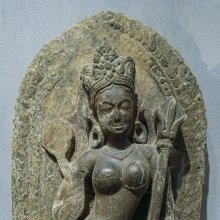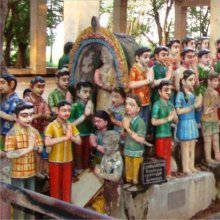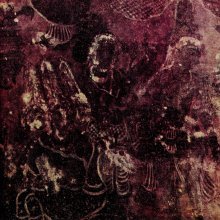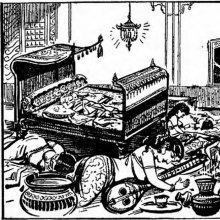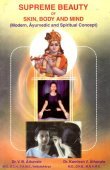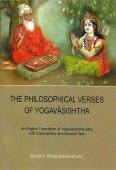Desire: 4 definitions
Introduction:
Desire means something in Hinduism, Sanskrit. If you want to know the exact meaning, history, etymology or English translation of this term then check out the descriptions on this page. Add your comment or reference to a book if you want to contribute to this summary article.
Images (photo gallery)
(+10 more images available)
In Hinduism
Yoga (school of philosophy)
Source: ORA: Amanaska (king of all yogas): A Critical Edition and Annotated Translation by Jason BirchDesires can be denoted by the Sanskrit terms Kāma, according to the Amanaska Yoga treatise which deals absorption, yogic powers and liberation.—The Amanaska referred to (or qualified) Samādhi with several terms, which are all negative; [e.g., it is devoid of all desire (sarva-kāma);] [...] The fact that such terminology is found in the Amanaska indicates that descriptions of Śiva and the void-like meditative states in Mantramargic Śaivism, were the basis of the descriptions of Samādhi and Paratattva (the highest reality) in this treatise. The Amanaska Yoga was consistent with the Pātañjala Yogaśāstra’s definition of Yoga, yet it described Samādhi in terms different to those of Pātañjalayoga; such as “that which is devoid of all desire (sarva-kāma)”.

Yoga is originally considered a branch of Hindu philosophy (astika), but both ancient and modern Yoga combine the physical, mental and spiritual. Yoga teaches various physical techniques also known as āsanas (postures), used for various purposes (eg., meditation, contemplation, relaxation).
Ayurveda (science of life)
Source: ORA: Amanaska (king of all yogas): (ayurveda)The Desire (for certain tastes) is denoted by the Sanskrit term Gṛddhi, according to the Kāśyapasaṃhitā (Khilasthāna, verse 9.43-45ab) in a chapter on abdominal swelling caused by vitiation of the blood.—Accordingly, “Listen to the cause of that which produces the cravings [of a seemingly pregnant woman with raktagulma]. Generally, there is desire for those tastes which cause an increase of the bodily constituents because of the true similarity of their origin. [When] the vitiated blood has a Vāta or Pitta [imbalance] and is accumulating, it fuels desire (gṛddhi) for tastes such as [those which are] acrid, sour, salty and so on”.
Source: International Research Journal of Ayurveda and Yoga: Role of Ayurveda in the Management of Manas Roga (Mental Disorders)Desire is denoted by the Sanskrit term Kāma and refers to one of the negative conditions of modern society.—Mental Health (according to Ayurveda) is brought about essentially as a result of unwholesome interaction between the individual and this environment. Epidemiological studies report prevalence rates for psychiatric disorders varying from 9.5 to 370/1000 population in India. [...]. In today’s metaphysical society, human life has become speedy, mechanized, and less effective and more centred, which contribute to more production of [e.g., Kama (Desire)].

Āyurveda (आयुर्वेद, ayurveda) is a branch of Indian science dealing with medicine, herbalism, taxology, anatomy, surgery, alchemy and related topics. Traditional practice of Āyurveda in ancient India dates back to at least the first millenium BC. Literature is commonly written in Sanskrit using various poetic metres.
Arthashastra (politics and welfare)
Source: Google Books: Way of Life: King, Householder, RenouncerDesire (in Sanskrit: Kāma) represents one of three “three pursuits of life”.—The Indian concept of ‘king of kings’ is intimately connected with the theme of the ‘good life’ as realised through the pursuit of puruṣārtha in Hindu traditions. The three goals of Kāma, Artha and Dharma are embraced by the term bhoga. The word for desire or wish, kāma, was also a word that meant will, intent, as well as pleasure and enjoyment. Without will or intent, without the desire for sons, success, paradise, or release from the world itself, none of these goals could be attained. So the problem with desire was not to do away with it, but to direct it toward the appropriate end. The critical distinction here, for Vaisnavas in particular, was the distinction between desires for personal results and a desire for the welfare of others. The former was to be subordinated to the latter. In fact, acts performed “without desire” (niṣkāma) for personal results were actually said to bring the greater rewards. If desire for one’s own enjoyment was to be subordinated to the desire for others’ well-being, so, too, was it to be subordinated to the goal of artha, the accumulation and distribution of the things, animals, and persons that made up one’s domain.

Arthashastra (अर्थशास्त्र, arthaśāstra) literature concerns itself with the teachings (shastra) of economic prosperity (artha) statecraft, politics and military tactics. The term arthashastra refers to both the name of these scientific teachings, as well as the name of a Sanskrit work included in such literature. This book was written (3rd century BCE) by by Kautilya, who flourished in the 4th century BCE.
See also (Relevant definitions)
Starts with: Desire For Deliverance, Desireless Deliverance, Desirelessness.
Ends with: Podesire, Sexual desire.
Full-text (+5997): Abhilasa, Kama, Iccha, Lobha, Spriha, Cikirsha, Chanda, Lalasa, Ipsita, Abhilashita, Akanksha, Aniccha, Icchabhanga, Purnakama, Abhikanksha, Vivaksha, Kanksha, Manoratha, Riramsa, Kamya.
Relevant text
Search found 522 books and stories containing Desire; (plurals include: Desires). You can also click to the full overview containing English textual excerpts. Below are direct links for the most relevant articles:
Mundaka Upanishad with Shankara’s Commentary (by S. Sitarama Sastri)
Verse 3.2.2 < [Mundaka III, Khanda II]
Verse 3.2.1 < [Mundaka III, Khanda II]
Verse 1.2.12 < [Mundaka I, Khanda II]
Bhagavati-sutra (Viyaha-pannatti) (by K. C. Lalwani)
Part 2 - On desires and experiences < [Chapter 7]
Part 4 - With senior monks from the order of Pārśva < [Chapter 9]
Part 2 - On suffering from delusion of faith < [Chapter 3]
A History of Indian Philosophy Volume 1 (by Surendranath Dasgupta)
Part 13 - Doctrine of Transmigration < [Chapter III - The Earlier Upaniṣads (700 B.c.— 600 B.c.)]
Part 14 - Emancipation < [Chapter III - The Earlier Upaniṣads (700 B.c.— 600 B.c.)]
Part 11 - Dissolution (Pralaya) and Creation (Srṣṭi) < [Chapter VIII - The Nyāya-Vaiśeṣika Philosophy]
Visuddhimagga (the pah of purification) (by Ñāṇamoli Bhikkhu)
Dependent Origination (ix): Clinging < [Chapter XVII - Dependent Origination (paññā-bhūmi-niddesa)]
The First Jhāna < [Chapter IV - The Earth Kasiṇa (Pathavī-kasiṇa-niddesa)]
Dependent Origination (x): Becoming < [Chapter XVII - Dependent Origination (paññā-bhūmi-niddesa)]
Taittiriya Upanishad Bhashya Vartika (by R. Balasubramanian)
Verse 2.122 < [Book 2 - Brahmavallī]
Verse 1.6 < [Book 1 - Śīkṣāvallī]
Verse 2.117 < [Book 2 - Brahmavallī]
Manusmriti with the Commentary of Medhatithi (by Ganganatha Jha)
Verse 2.2 < [Section II - Selfishness Deprecated]
Verse 2.94 < [Section XVIII - Control of Sensual Desires]
Verse 2.4 [Pūrvapakṣa concluded] < [Section II - Selfishness Deprecated]
Related products
(+13 more products available)
